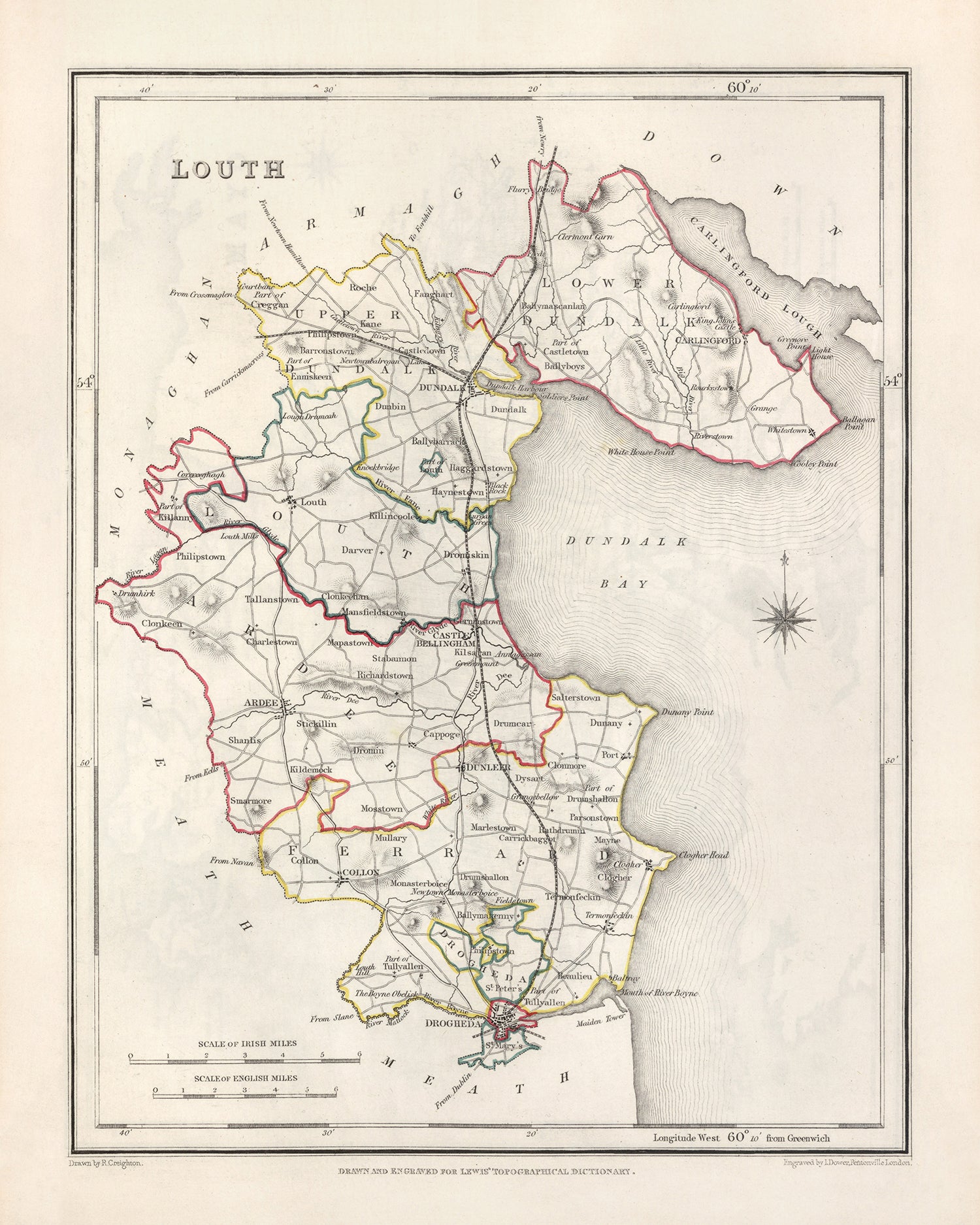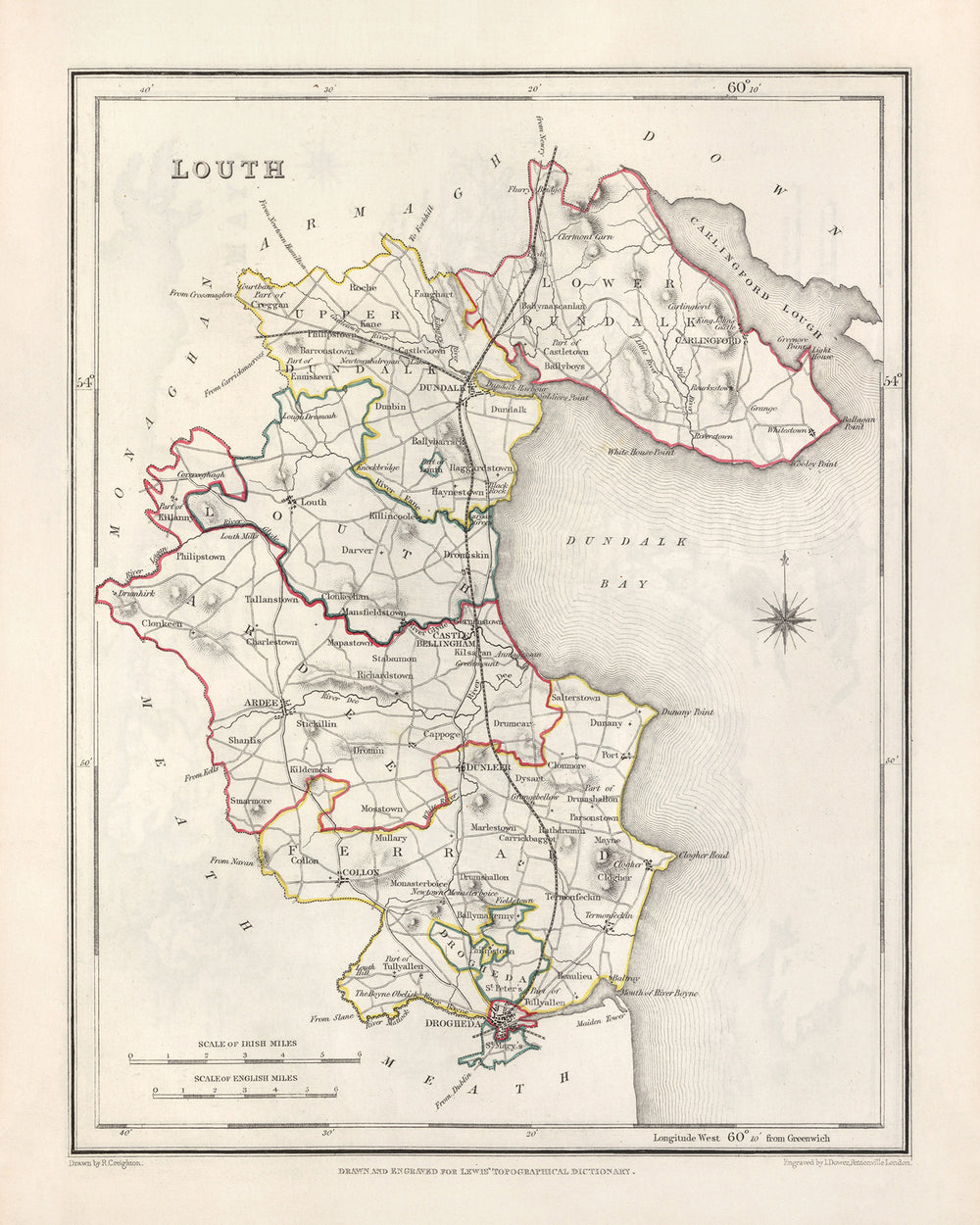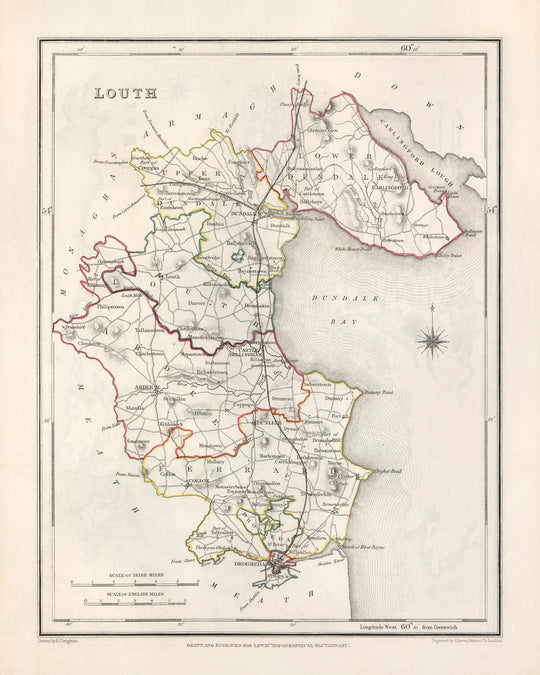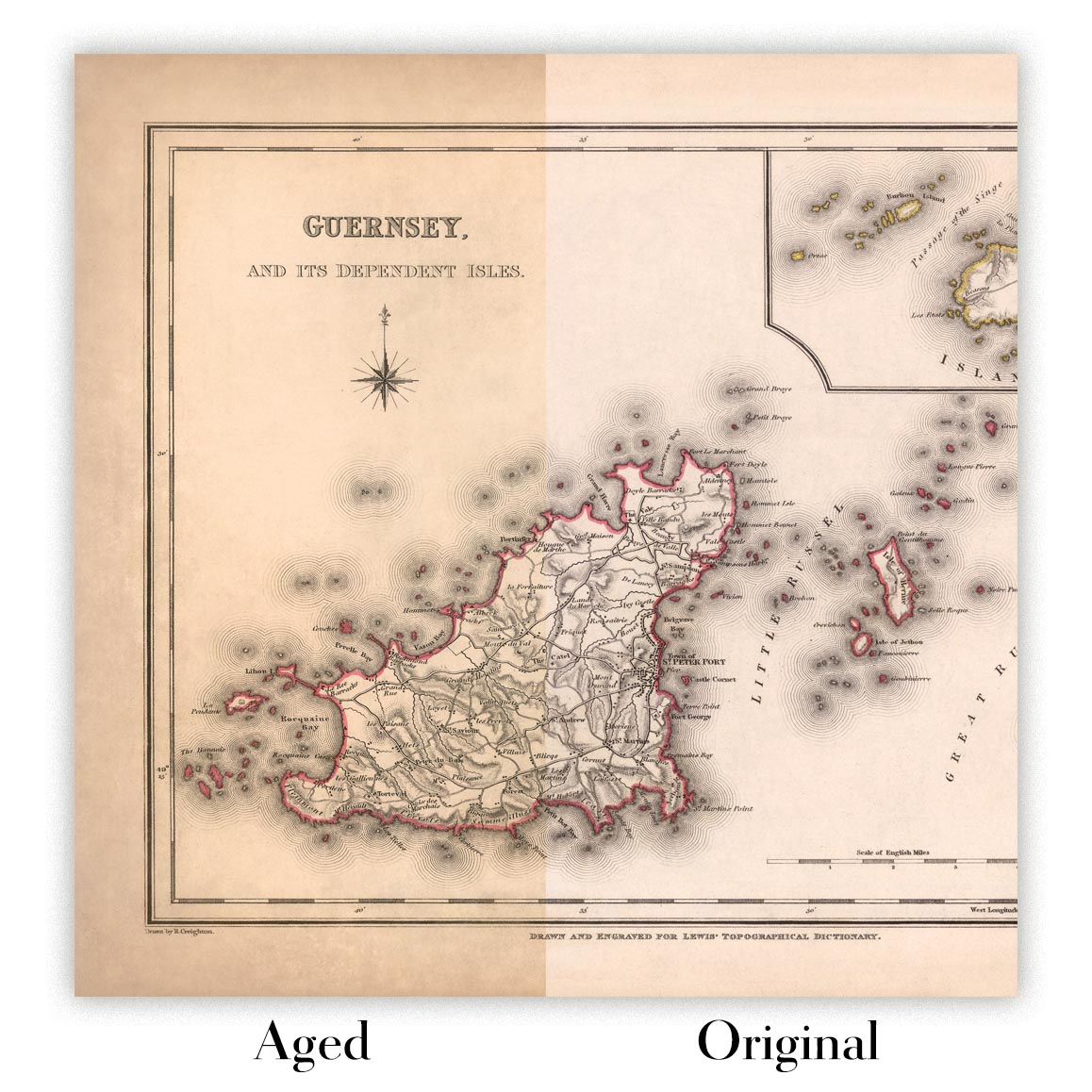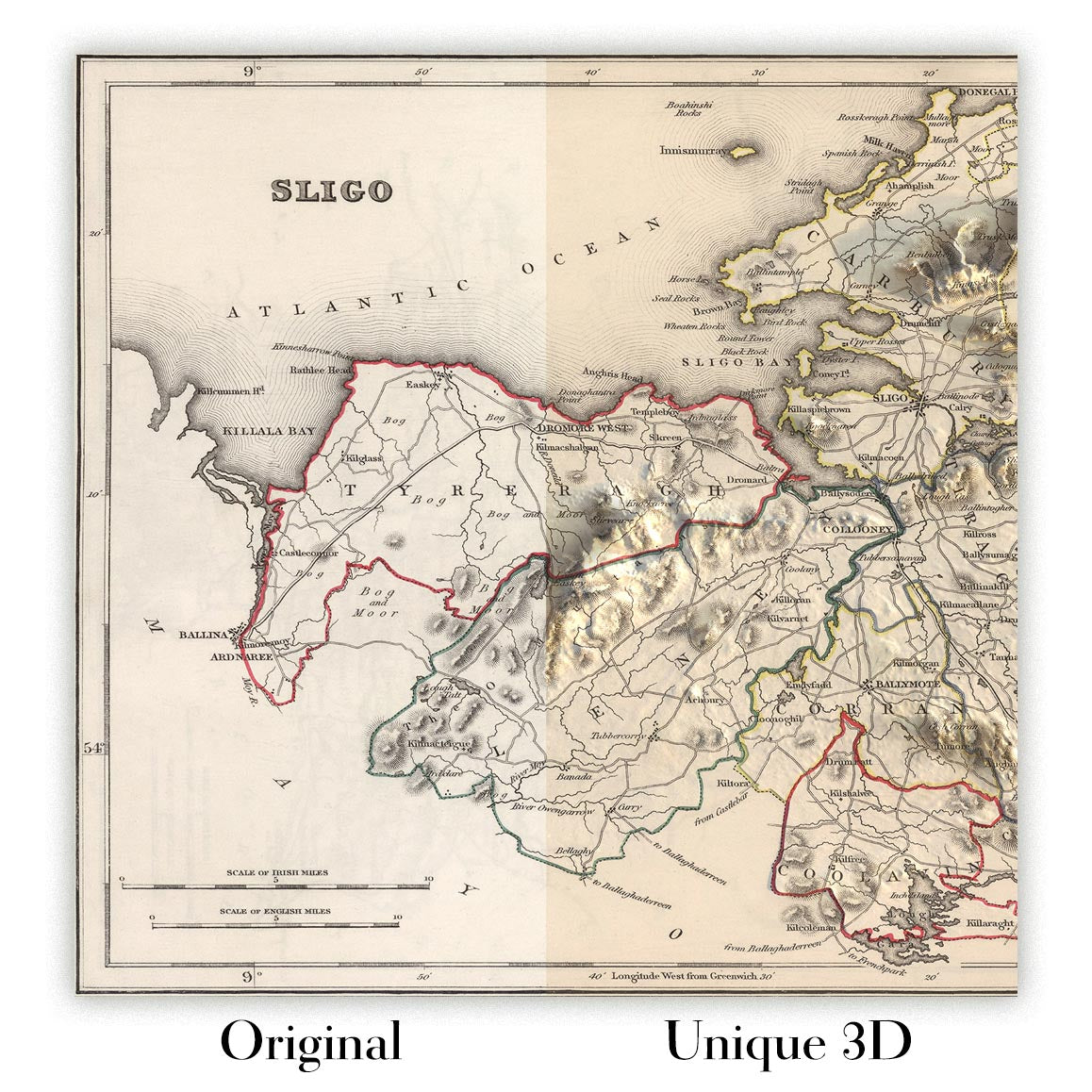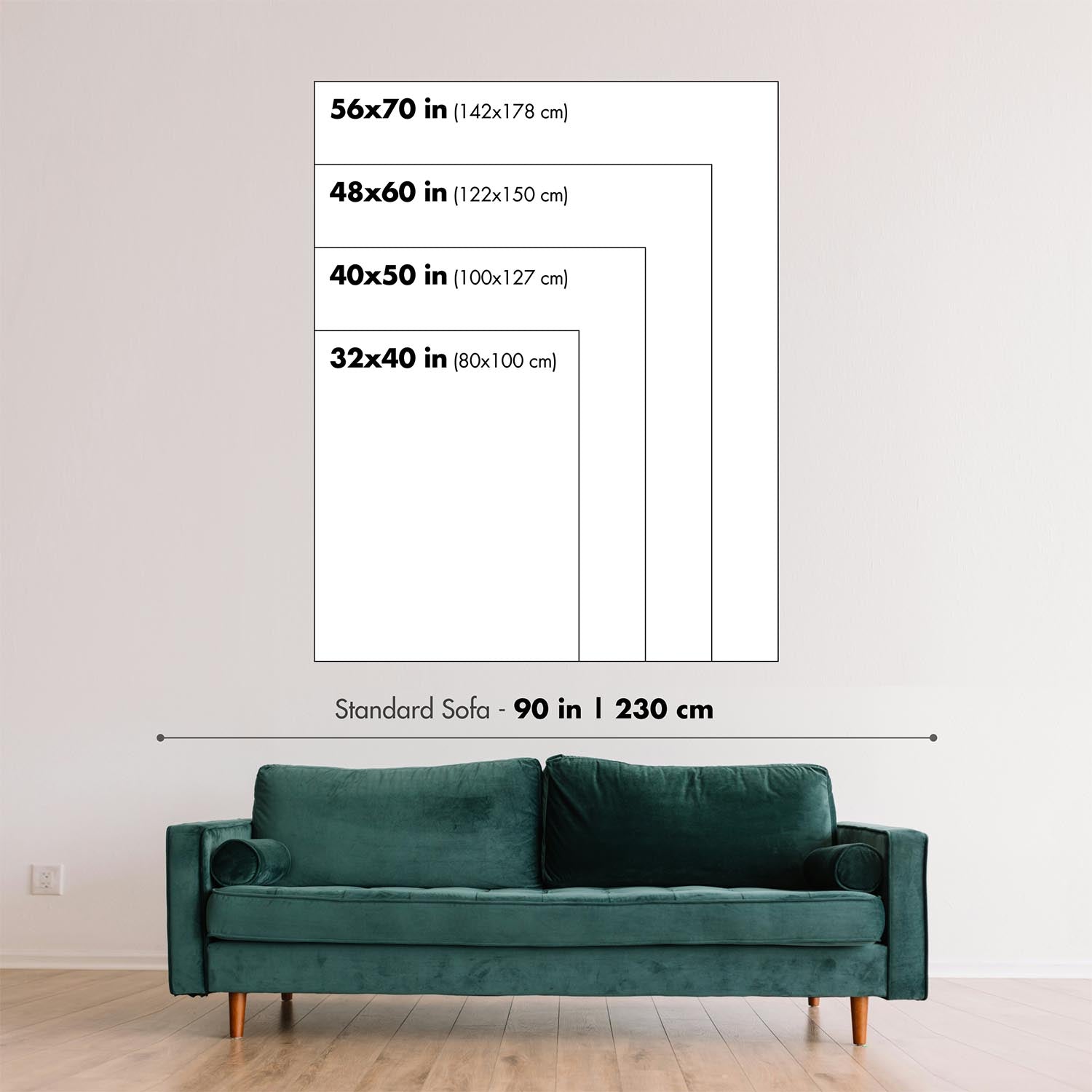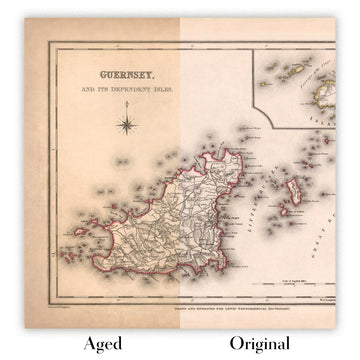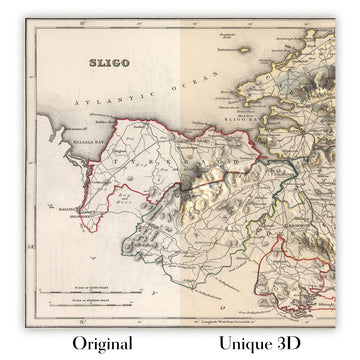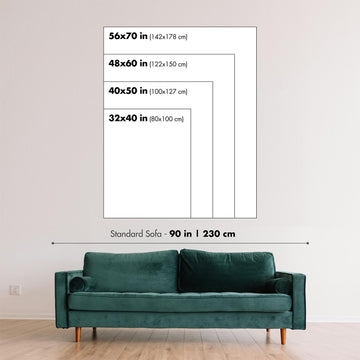- Handmade locally. No import duty or tax
- FREE Delivery by Christmas
- Love it or your money back (90 days)
- Questions? WhatsApp me any time
Own a piece of history
5,000+ 5 star reviews


The Old Map of Louth by Samuel Lewis, created in 1844, is a captivating piece that offers a glimpse into the historical landscape of County Louth, Ireland. This map holds immense value for history enthusiasts and cartography aficionados alike. Its intricate details and accurate depiction of the region make it a fascinating and beautiful map to own.
One of the intriguing aspects of this map is its portrayal of the major towns, cities, and other notable features of County Louth. It is important to note that while some modern cities may not be included on this map, others may appear under earlier names, adding an exciting layer of historical significance. This map provides a unique opportunity to explore the region as it stood in 1844, allowing us to trace the evolution of settlements and landmarks over time.
Notable Settlements Founded Before 1840
- Dundalk (1189): Known for its rich Viking heritage, Dundalk is a bustling town that has played a significant role in Irish history. Its strategic location near the border with Northern Ireland has made it an important center for trade and commerce.
- Drogheda (1194): A town with a storied past, Drogheda boasts a history dating back to ancient times. It was a key stronghold during the Norman invasion and witnessed several pivotal events during the medieval period.
- Ardee (13th century): Nestled in the heart of County Louth, Ardee is a town steeped in history. Its origins can be traced back to the medieval era, and it has been a vibrant hub of trade and culture throughout the centuries.
- Carlingford (12th century): Situated on the scenic Carlingford Lough, this charming town has a rich maritime history. Its picturesque streets and well-preserved medieval architecture make it a popular tourist destination.
- Cooley Peninsula: Jutting out into the Irish Sea, the Cooley Peninsula is a stunning landscape of rugged beauty. Its rolling hills, ancient monuments, and breathtaking views make it a must-visit for nature enthusiasts and history buffs alike.
Other notable settlements founded before 1840 within County Louth include:- Dromiskin (6th century): Known for its early Christian heritage, Dromiskin is home to the ruins of an ancient monastery.- Tallanstown (15th century): A quaint village with a rich agricultural history, Tallanstown is surrounded by lush green fields and picturesque landscapes.- Togher (12th century): This historic village is renowned for its well-preserved medieval church, which stands as a testament to its past.- Castlebellingham (14th century): A village steeped in medieval charm, Castlebellingham is home to the impressive Bellingham Castle, a testament to its historical significance.
And many more...
Notable Natural Features and Tourist Attractions
- Cooley Mountains: This majestic mountain range dominates the landscape of County Louth, offering breathtaking views and opportunities for outdoor activities such as hiking and mountaineering.
- Carlingford Lough: A picturesque fjord-like inlet, Carlingford Lough is renowned for its natural beauty and is a popular spot for sailing, fishing, and scenic walks along its shores.
- River Boyne: Flowing through County Louth, the River Boyne is steeped in history and legend. It is famous for its association with the Battle of the Boyne, a significant event in Irish history.
Historical Events in County Louth (1800-1850)
- Battle of Tullyallen (1831): A clash between the British Army and Irish rebels, the Battle of Tullyallen was part of the larger Irish Rebellion of 1831. It took place near the village of Tullyallen in County Louth.
- Great Famine (1845-1852): County Louth, like the rest of Ireland, was severely affected by the Great Famine. This devastating period of mass starvation and emigration had a profound impact on the region's population and economy.
Immerse yourself in the rich history and captivating beauty of County Louth with the Old Map of Louth by Samuel Lewis, 1844. This meticulously crafted map offers a window into the past, allowing you to explore the historical landscape and trace the footsteps of those who came before.
Please double check the images to make sure that a specific town or place is shown on this map. You can also get in touch and ask us to check the map for you.
This map looks great at all sizes: 12x16in (30.5x41cm), 16x20in (40.5x51cm), 18x24in (45.5x61cm), 24x30in (61x76cm), 32x40in (81.5x102cm) and 40x50in (102x127cm), but it looks even better when printed large.
I can create beautiful, large prints of this map up to 50in (127cm). Please get in touch if you're looking for larger, customised or different framing options.
The model in the listing images is holding the 16x20in (40.5x51cm) version of this map.
The fifth listing image shows an example of my map personalisation service.
If you’re looking for something slightly different, check out my main collection of UK and Ireland maps.
Please contact me to check if a certain location, landmark or feature is shown on this map.
This would make a wonderful birthday, Christmas, Father's Day, work leaving, anniversary or housewarming gift for someone from the areas covered by this map.
This map is available as a giclée print on acid free archival matte paper, or you can buy it framed. The frame is a nice, simple black frame that suits most aesthetics. Please get in touch if you'd like a different frame colour or material. My frames are glazed with super-clear museum-grade acrylic (perspex/acrylite), which is significantly less reflective than glass, safer, and will always arrive in perfect condition.
This map is also available as a float framed canvas, sometimes known as a shadow gap framed canvas or canvas floater. The map is printed on artist's cotton canvas and then stretched over a handmade box frame. We then "float" the canvas inside a wooden frame, which is available in a range of colours (black, dark brown, oak, antique gold and white). This is a wonderful way to present a map without glazing in front. See some examples of float framed canvas maps and explore the differences between my different finishes.
For something truly unique, this map is also available in "Unique 3D", our trademarked process that dramatically transforms the map so that it has a wonderful sense of depth. We combine the original map with detailed topography and elevation data, so that mountains and the terrain really "pop". For more info and examples of 3D maps, check my Unique 3D page.
For most orders, delivery time is about 3 working days. Personalised and customised products take longer, as I have to do the personalisation and send it to you for approval, which usually takes 1 or 2 days.
Please note that very large framed orders usually take longer to make and deliver.
If you need your order to arrive by a certain date, please contact me before you order so that we can find the best way of making sure you get your order in time.
I print and frame maps and artwork in 23 countries around the world. This means your order will be made locally, which cuts down on delivery time and ensures that it won't be damaged during delivery. You'll never pay customs or import duty, and we'll put less CO2 into the air.
All of my maps and art prints are well packaged and sent in a rugged tube if unframed, or surrounded by foam if framed.
I try to send out all orders within 1 or 2 days of receiving your order, though some products (like face masks, mugs and tote bags) can take longer to make.
If you select Express Delivery at checkout your order we will prioritise your order and send it out by 1-day courier (Fedex, DHL, UPS, Parcelforce).
Next Day delivery is also available in some countries (US, UK, Singapore, UAE) but please try to order early in the day so that we can get it sent out on time.
My standard frame is a gallery style black ash hardwood frame. It is simple and quite modern looking. My standard frame is around 20mm (0.8in) wide.
I use super-clear acrylic (perspex/acrylite) for the frame glass. It's lighter and safer than glass - and it looks better, as the reflectivity is lower.
Six standard frame colours are available for free (black, dark brown, dark grey, oak, white and antique gold). Custom framing and mounting/matting is available if you're looking for something else.
Most maps, art and illustrations are also available as a framed canvas. We use matte (not shiny) cotton canvas, stretch it over a sustainably sourced box wood frame, and then 'float' the piece within a wood frame. The end result is quite beautiful, and there's no glazing to get in the way.
All frames are provided "ready to hang", with either a string or brackets on the back. Very large frames will have heavy duty hanging plates and/or a mounting baton. If you have any questions, please get in touch.
See some examples of my framed maps and framed canvas maps.
Alternatively, I can also supply old maps and artwork on canvas, foam board, cotton rag and other materials.
If you want to frame your map or artwork yourself, please read my size guide first.
My maps are extremely high quality reproductions of original maps.
I source original, rare maps from libraries, auction houses and private collections around the world, restore them at my London workshop, and then use specialist giclée inks and printers to create beautiful maps that look even better than the original.
My maps are printed on acid-free archival matte (not glossy) paper that feels very high quality and almost like card. In technical terms the paper weight/thickness is 10mil/200gsm. It's perfect for framing.
I print with Epson ultrachrome giclée UV fade resistant pigment inks - some of the best inks you can find.
I can also make maps on canvas, cotton rag and other exotic materials.
Learn more about The Unique Maps Co.
Map personalisation
If you're looking for the perfect anniversary or housewarming gift, I can personalise your map to make it truly unique. For example, I can add a short message, or highlight an important location, or add your family's coat of arms.
The options are almost infinite. Please see my map personalisation page for some wonderful examples of what's possible.
To order a personalised map, select "personalise your map" before adding it to your basket.
Get in touch if you're looking for more complex customisations and personalisations.
Map ageing
I have been asked hundreds of times over the years by customers if they could buy a map that looks even older.
Well, now you can, by selecting Aged before you add a map to your basket.
All the product photos you see on this page show the map in its Original form. This is what the map looks like today.
If you select Aged, I will age your map by hand, using a special and unique process developed through years of studying old maps, talking to researchers to understand the chemistry of aging paper, and of course... lots of practice!
If you're unsure, stick to the Original colour of the map. If you want something a bit darker and older looking, go for Aged.
If you are not happy with your order for any reason, contact me and I'll get it fixed ASAP, free of charge. Please see my returns and refund policy for more information.
I am very confident you will like your restored map or art print. I have been doing this since 1984. I'm a 5-star Etsy seller. I have sold tens of thousands of maps and art prints and have over 5,000 real 5-star reviews. My work has been featured in interior design magazines, on the BBC, and on the walls of dozens of 5-star hotels.
I use a unique process to restore maps and artwork that is massively time consuming and labour intensive. Hunting down the original maps and illustrations can take months. I use state of the art and eye-wateringly expensive technology to scan and restore them. As a result, I guarantee my maps and art prints are a cut above the rest. I stand by my products and will always make sure you're 100% happy with what you receive.
Almost all of my maps and art prints look amazing at large sizes (200cm, 6.5ft+) and I can frame and deliver them to you as well, via special oversized courier. Contact me to discuss your specific needs.
Or try searching for something!







